Nicola Cornick's Blog, page 22
February 23, 2012
The Audie Awards!
I was very happy and excited to hear that Notorious had been shortlisted for an Audie Award for Best Romance Audiobook of the Year! The shortlist is here - as you can see,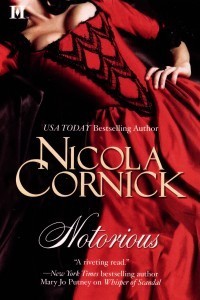 Notorious is in great company! I've read the books by Eloisa James and Susanna Kearsley and enjoyed them enormously. The greatest credit for the nomination, however, must go to the narrator, Katy Kellgren, who is something of an audio star. Katy has EIGHT Audie nominations this year!
Notorious is in great company! I've read the books by Eloisa James and Susanna Kearsley and enjoyed them enormously. The greatest credit for the nomination, however, must go to the narrator, Katy Kellgren, who is something of an audio star. Katy has EIGHT Audie nominations this year!
When Katy was preparing to record Notorious she contacted me with various questions about the book and its interpretation. I was hugely impressed by the amount of work she puts in to preparing for each book. We got chatting and I interviewed her for the Word Wenches here. The insight she gave us into the world of the audiobook narrator was completely fascinating.
I'd like to thank Katy very much and congratulate her on such an awesome list of nominations. I am very proud and honoured that Notorious is one of the audiobooks shortlisted.
Desired is also available as an audiobook from Audible. Many years ago Lord Greville's Captive was also turned into an audiobook and serialised on the radio as well. But remember that romance audiobooks should carry a health warning – don't listen to them in the car if you are easily distracted by those passionate scenes! A friend of mine almost drove into the back of someone else whilst listening to Michael Praed reading a historical romance. Richard Armitage's audiobooks could be equally dangerous and various other actors with dark and delicious voices!
©2012 Nicola Cornick. All Rights Reserved.
.February 21, 2012
Blog Prize Winners!
Congratulations to Betty and Brandy, whose names were picked from the hat to win a copy of Dauntsey Park in the blog contest! Thank you to everyone who shared a random fact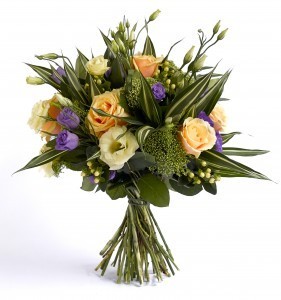 about themselves – there were some awesome facts there. As always, it's lovely to chat to you all so please keep commenting on the blog. Thank you!
about themselves – there were some awesome facts there. As always, it's lovely to chat to you all so please keep commenting on the blog. Thank you!
©2012 Nicola Cornick. All Rights Reserved.
.February 17, 2012
I've been honoured with a blog award!
I am very touched and honoured to have received my very first blog award, from good friend and fellow RNA member Rachel Brimble. Receiving this award means sharing 7 random facts about myself, which is a challenging prospect. This is what I have come up with:
facts about myself, which is a challenging prospect. This is what I have come up with:
One of my favourite meals is monkfish with garlic and new potatoes. I first ate it in a little pub at the seaside on the west coast of Ireland and I've loved it ever since.
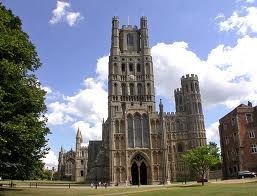 I've been to some amazing places including The Arctic, the rainforest and on the roof of Ely Cathedral's lantern tower.
I've been to some amazing places including The Arctic, the rainforest and on the roof of Ely Cathedral's lantern tower.
My grandfather was a poet. I love reading poetry but I can't write it.
I'm a big admirer of birds of prey. My favourite is the Red Kite.
When I took my Spoken English certificate at school the book I chose to read aloud from was Georgette Heyer's The Talisman Ring. I passed with credit!
I can't write with the TV or radio on as it interrupts my concentration but I can write listening to music.
I come from a family of gardeners. Sadly I haven't inherited their talent!
I'm passing on this award to seven other blogs I think are great:
An honourable mention to Julie Cohen's wonderful blog too; I know she has already been nominated!
To share the love with readers as well as bloggers, I'm offering two copies of Dauntsey Park to commenters who share a random fact about themselves here on the blog. I'll make the drawing on Monday. Happy weekend!
©2012 Nicola Cornick. All Rights Reserved.
.February 10, 2012
Regency Theatre
 Today at the Word Wenches I am blogging about the theatre in the Georgian and Regency period. Come and join us to chat about your favourite plays and your favourite books that feature theatricals!
Today at the Word Wenches I am blogging about the theatre in the Georgian and Regency period. Come and join us to chat about your favourite plays and your favourite books that feature theatricals!
©2012 Nicola Cornick. All Rights Reserved.
.February 6, 2012
The London Season – The Derby
In 1779 the 12th Earl of Derby leased a house in Epsom called The Oaks. Whilst there he and a friend decided to start a new race for 3 year old fillies to be run over one and a half miles. He called it The Oaks. The following year a similar race was run for colts. It was decided that the race should be named after either the host of the party or one of his guests, Sir Charles Bunbury. According to legend the decision was made by the toss of a coin or perhaps the guests decided that The Bunbury didn't sound as good as The Derby. Lord Rosebery commented: "A roistering party at a country house founded two races and named them after their host and his house. Seldom has a carouse had a more permanent effect."
He called it The Oaks. The following year a similar race was run for colts. It was decided that the race should be named after either the host of the party or one of his guests, Sir Charles Bunbury. According to legend the decision was made by the toss of a coin or perhaps the guests decided that The Bunbury didn't sound as good as The Derby. Lord Rosebery commented: "A roistering party at a country house founded two races and named them after their host and his house. Seldom has a carouse had a more permanent effect."
The Derby was run on a Wednesday or a Thursday in June and on the day huge crowds would come from out London to enjoy the Epsom Fair. This included magicians, conjurors, musicians, clowns and side shows. During some of the 19th century and most of the 20th Parliament would adjourn to allow members to attend the race meeting. The Epsom Derby is still one of the most prestigious events in the horse racing calendar.
©2012 Nicola Cornick. All Rights Reserved.
.February 2, 2012
The London Season – The Fourth of June
The Fourth of June was the Open Day at Eton College. It started in the 18th century as a gala in honour of King George III's birthday. It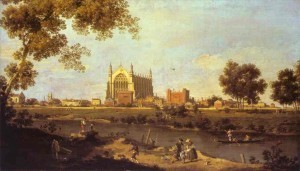 soon became a very popular outing for the Ton, who flocked out of London to enjoy the riverside pageant.
soon became a very popular outing for the Ton, who flocked out of London to enjoy the riverside pageant.
The river procession, with fireworks, was first recorded in 1793 and by tradition the dress worn was that of Nelson's Navy: white trousers, striped shirts, blue jackets plus – ahem – straw hats decked with flowers. No, not for the ladies – for the men. One has to be bred to tradition over several hundred years to be able to wear such a hat with aplomb. The rowing boats were also named after Navy ships.
Other traditions that were part of the 4th June celebrations included "Montem." This was a custom whereby the Eton schoolboys would hold up carriages in the nearby town of Slough for money. Yes, legalised highway robbery by those at the top of society!
©2012 Nicola Cornick. All Rights Reserved.
.January 31, 2012
The London Season – The Royal Academy Exhibition
A couple of weeks ago I was tidying out my bookcases and came across a fascinating book that gave the historical background to the events of the London Season. I thought I would share the origin of some of the events that by the Regency period had come to be major occasions in the social calendar.
events of the London Season. I thought I would share the origin of some of the events that by the Regency period had come to be major occasions in the social calendar.
The Royal Academy Summer Exhibition began in the 18th century. Prior to this you could only look at paintings in royal or private collections or on the Grand Tour. In 1768 a group of artists asked George III to give his blessing to an academy that would both teach art and exhibit it. The 34 founding Members were a group of prominent artists and architects including Sir Joshua Reynolds and Sir Thomas Gainsborough. They were determined to achieve professional standing for British art and architecture. They also wanted to provide a venue for exhibitions that would be open to the public. George III marked the establishment of the new academy with a painting by Zoffany.
The first show, in 1769, contained 136 pictures. It took place in a hired room in a building in Pall Mall. Later the show moved to the top floor of Somerset House. Queen Charlotte had to rest between floors because the climb was so steep. Dr Johnson complained that it was an endurance test simply to attend a viewing. Today the Royal Academy of Art is situated in Burlington House, a magnificent mansion in the heart of London.
The Academy has held an exhibition every summer since 1769. This takes place in May at the start of the Season.
©2012 Nicola Cornick. All Rights Reserved.
.January 27, 2012
Inspiration from Rochester!
Today I am blogging about Rochester the guide dog puppy and his work over at the Word Wench blog. The link is here! I've also mentioned a little bit of history. I've been fascinated by the history of the domestic dog for a long time, and their close relationship with humans. It's also wonderful to find out more about where the Labrador comes from (I guess the clue is in the name!) but I also had no idea that Golden Retrievers originated in Scotland.
Wench blog. The link is here! I've also mentioned a little bit of history. I've been fascinated by the history of the domestic dog for a long time, and their close relationship with humans. It's also wonderful to find out more about where the Labrador comes from (I guess the clue is in the name!) but I also had no idea that Golden Retrievers originated in Scotland.
In my post I mention what it is like to be trying to write, research and train Rochester all at the same time! He is a full on commitment but like all puppies he does sleep a lot so I do get plenty of time to work. I've also found it very relaxing sitting on the floor reading with a warm puppy happily sleeping on my knee. For more on Rochester, check out his blog Puppy with a Purpose!
©2012 Nicola Cornick. All Rights Reserved.
.January 23, 2012
Big Cats!
Still on the subject of cats today, although of a size larger than Dr Johnson's pet, Hodge, and your average domestic cat.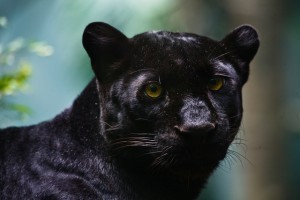
Interest in "big cats" in the UK has been sparked again by the case of "the wild cat of Woodchester," a big black cat thought to be the size of a puma which is reported to be attacking deer on the National Trust estate of Woodchester Park in the Cotswolds. (Woodchester Mansion is fabulous for a visit – here is the website and there is a photo below.) The result of DNA tests due this week should prove if this is a cat attack or not. Big cat incidents have been reported for years in the UK and divide opinion. Our last native big cat was the lynx, which died out in medieval times. This is borne out by pieces of linguist evidence; a 7th century lullaby lists the animals killed by a hunter and one of these is the "llewyn," which is thought to be translated as lynx. A medieval Welsh poem, Pa Gwr, recorded in the Black Book of Carmarthen, also mentions "cath Palug", a big cat.
 Jump to the 1960s and 1970s and it was both legal and fashionable to keep exotic big cats as pets. However in 1976 the government introduced the Dangerous Wild Animals Act amidst growing concern for public safety and also for the welfare of the animals. Owners were required to get a licence and ensure that the pets were kept in suitable conditions. As a result some big cat owners donated their pets to zoos. Others set them free to fend for themselves in the wild. It is therefore perfectly logical that subsequent reports of big cat activity in the UK could result from these releases. But what about the centuries in between the extinction of the lynx and the appearance of this new wave of big cats and their descendants? How can one explain big cat sightings from this period? Did the aristocrats who brought back antiquities from their travels abroad also return with exotic animals for their menageries which subsequently escaped or were released? Did the travelling circuses lose some of their exotic animals?
Jump to the 1960s and 1970s and it was both legal and fashionable to keep exotic big cats as pets. However in 1976 the government introduced the Dangerous Wild Animals Act amidst growing concern for public safety and also for the welfare of the animals. Owners were required to get a licence and ensure that the pets were kept in suitable conditions. As a result some big cat owners donated their pets to zoos. Others set them free to fend for themselves in the wild. It is therefore perfectly logical that subsequent reports of big cat activity in the UK could result from these releases. But what about the centuries in between the extinction of the lynx and the appearance of this new wave of big cats and their descendants? How can one explain big cat sightings from this period? Did the aristocrats who brought back antiquities from their travels abroad also return with exotic animals for their menageries which subsequently escaped or were released? Did the travelling circuses lose some of their exotic animals?
In the 1760s the author William Cobbett wrote in his Rural Rides that as a boy he had seen a cat the size of a medium-sized Spaniel dog climb into a hollow elm tree in the grounds of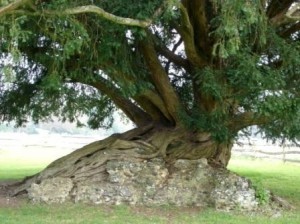 Waverley Abbey in Surrey (website here, another fabulous place to visit). A medium-sized spaniel isn't very big but Cobbett was later in Canada and saw a lynx there, which he commented was exactly like the cat he had seen at Waverley. Nor was he alone in his sighting. Newspaper reports from the 18th and 19th century also record reports of big cats. One in The Times from 1827 reported that a lynx had been seen in the UK. Another in 1927 reported a lynx trapped by a Scottish farmer. These reports raise the tantalising possiblity that the lynx never completely died out in Britain.
Waverley Abbey in Surrey (website here, another fabulous place to visit). A medium-sized spaniel isn't very big but Cobbett was later in Canada and saw a lynx there, which he commented was exactly like the cat he had seen at Waverley. Nor was he alone in his sighting. Newspaper reports from the 18th and 19th century also record reports of big cats. One in The Times from 1827 reported that a lynx had been seen in the UK. Another in 1927 reported a lynx trapped by a Scottish farmer. These reports raise the tantalising possiblity that the lynx never completely died out in Britain.
Another mythological explanation is given for the belief in big cats. For centuries there has existed the myth of the Black Dog, so famously explored in Conan Doyle's The Hound of the Baskervilles. This ghostly creature is said to haunt wild moorland and other remote places. Perhaps big cats are the modern successor to the myth of the ghostly black dog. As someone who has seen a big cat myself, many years ago in rural Somerset, I am awaiting the results of the tests from the Wild cat of Woodchester with a great deal of interest. What do you think? Do these "mythical" beasts, whether they are big cats, yetis, the Loch Ness Monster or other mysterious creatures really exist?
©2012 Nicola Cornick. All Rights Reserved.
.January 18, 2012
Dr Johnson's Cat
Dr Johnson, compiler of the English Dictionary of 1755, defined the cat thus: "A domestick animal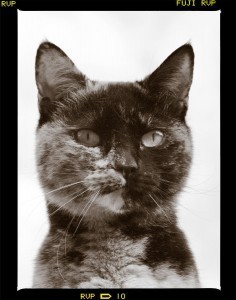 that catches mice, commonly reckoned by naturalists the lowest order of the leonine species." I'm not sure what my pet cat Bob (Roberta) would make of being defined as the lowest of anything! She rates herself far more highly than that.
that catches mice, commonly reckoned by naturalists the lowest order of the leonine species." I'm not sure what my pet cat Bob (Roberta) would make of being defined as the lowest of anything! She rates herself far more highly than that.
Dr Johnson himself owned a cat, Hodge (the name is derived from 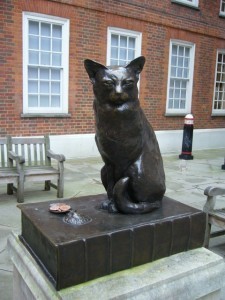 Roger), of whom he was very fond. His biographer Boswell wrote: "I will never forget the indulgence with which Dr Johnson treated his cat, Hodge, for whom he himself used to go out and buy oysters lest the servants, having the trouble, should take a dislike to the poor creature." Boswell unfortunately had an antipathy towards cats and so had a very unhappy time when he was visiting Johnson and the cat was also in the room. Cats so often spot the person who is uncomfortable with them and then deliberately approach them!
Roger), of whom he was very fond. His biographer Boswell wrote: "I will never forget the indulgence with which Dr Johnson treated his cat, Hodge, for whom he himself used to go out and buy oysters lest the servants, having the trouble, should take a dislike to the poor creature." Boswell unfortunately had an antipathy towards cats and so had a very unhappy time when he was visiting Johnson and the cat was also in the room. Cats so often spot the person who is uncomfortable with them and then deliberately approach them!
There is a memorial to Hodge, whom Johnson called "a very fine cat indeed" in Gough Square, where Johnson lived for 11 years.
©2012 Nicola Cornick. All Rights Reserved.
.


